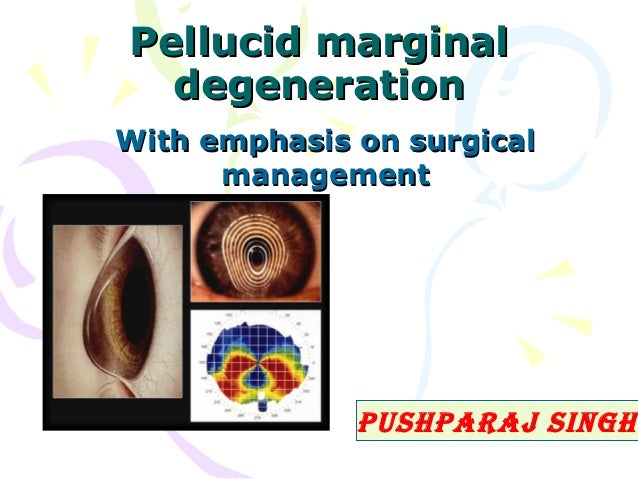

This patient will never need to undergo corneal transplant surgery. In addition he has been able to wear his lenses every day with all day lens wear comfortably. His vision has remained at 20/20 with his GVR lenses. Every year this patient has returned to our office for yearly examinations, the latest being today.

The term pellucid marginal degeneration was coined first by Schalaeppi in 1957 as 'la dystrophie marginale inferieure pellucide de la cornee'. The ectatic zone, which is 1-2 mm from the limbus, lies above the point of the maximum corneal thinning. It is characterized by a peripheral crescentic band of thinning, usually in the inferior cornea. In 2008, we fit this patient with GVR Scleral lenses which have provided this gentleman with 20/20 vision in each eye. Pellucid marginal corneal degeneration (PMCD) is a bilateral, noninflammatory, peripheral corneal thinning disease. He was also unable to obtain functional vision with eyeglasses. Pellucid marginal corneal degeneration is a bilateral corneal ectasia characterized by a band of clear thinning that runs approximately 1 to 2 mm inside and. Over these years he tried many different types of contact lenses without success. Protrusion of the cornea occurs above a band of thinning, which is located 1 to 2 mm from the limbus and measures 1 to 2 mm in width. A number of doctors told him that his only option was to have corneal transplant surgery in both eyes. Pellucid marginal degeneration of the cornea is a bilateral, clear, inferior, peripheral corneal-thinning disorder. Over the years he visited a number of major eye institutions and clinics throughout the United States trying to get help. A 34-year-old woman had simultaneous photorefractive keratectomy and corneal collagen cross- linking with riboflavinultraviolet-A irradiation for the. Pellucid marginal corneal degeneration (PMD) is a bilateral, non-inflammatory, peripheral corneal thinning disease characterised by a thinning peripheral. When this patient first visited our office, his visual acuity was 20/800 in each eye. Note in the photo below the protrusion or bulging of the upper portion of this cornea. Eyes with paralimbal thinning were supposed as having PMD and included. This patient suffers from a very rare form of keratoconus known as “Superior Pellucid Marginal Degeneration.” This type of corneal ectasia affects the upper half of both of his corneas. Methods: In eyes with a crab-claw pattern on corneal topography of a study cohort of 808 eyes, manual measurements of the cornea's thinnest point on the inferior vertical Scheimpflug image (mCTi) and on the superior vertical Scheimpflug image (mCTs) were conducted. The patient in the photo with me lives in the Bahamas and first visited our office in 2008.


 0 kommentar(er)
0 kommentar(er)
